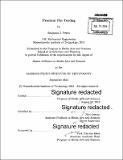Practical pin tooling
Author(s)
Peters, Benjamin J
DownloadFull printable version (11.16Mb)
Other Contributors
Massachusetts Institute of Technology. Department of Architecture. Program in Media Arts and Sciences.
Advisor
Neri Oxman.
Terms of use
Metadata
Show full item recordAbstract
A high resolution reconfigurable mold has been sought after for over 150 years. An ideal reconfigurable mold would be capable of producing detailed surfaces for use in molding and be capable of fast surface reconfiguration. Such a device would combine the fast speed and repeatability of formative processes, like injection molding, with the flexibility of additive processes, like 3D printing. An affordable, high resolution, reconfigurable mold could be a practical tool for a lean, short-run shop or factory, serving as a resin mold, fixturing surface or concrete formwork; to name only a few possible applications. Resembling the common pin art toy, a discrete element pin bed has often been proposed as a design for a reconfigurable mold. Conventional actuation strategies are often cumbersome and expensive, due to the quadratic increase in number of pin elements with increasing surface resolution. Very few designs exist that are capable of producing a reconfigurable pin array at sufficiently high resolution to compete with the cost of making a fixed geometry mold. A practical pin tool, an inexpensive but high resolution molding tool, could be an asset to shops and small business everywhere, but nothing like this currently exists. This thesis presents a concise design strategy, backed up by analytical arguments and empirical evidence which can used to construct an affordable, high resolution reconfigurable pin tool. We address the challenge of quadratic scaling by edge-addressing simple, nonlinear mechanisms to actuate each pin. Edge addressing, along rows and columns of pins, reduces the number of control inputs to a small, linearly increasing value. Nonlinear mechanisms at each discrete pin site allow for a predictable, localized expression of the edge addressed inputs. Two embodiments of this design strategy are proposed and tested. First, a diode/resistive heater array allows for electrical edge addressing and control of a fusible alloy brake to grip or release targeted, sliding pins. Second, an array of screws is edge addressed by mechanical oscillations to generate nonlinear tangential forces in targeted screws, resulting in controllable screw translations. We conclude by summarizing our results and discuss directions for future work.
Description
Thesis: S.M., Massachusetts Institute of Technology, School of Architecture and Planning, Program in Media Arts and Sciences, 2013. Cataloged from PDF version of thesis. Includes bibliographical references (pages 69-70).
Date issued
2013Department
Program in Media Arts and Sciences (Massachusetts Institute of Technology)Publisher
Massachusetts Institute of Technology
Keywords
Architecture. Program in Media Arts and Sciences.